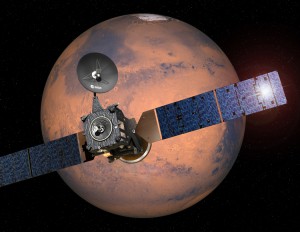ExoMars Good and Bad
November 3, 2016
Last month, on October 19, Mars claimed another victim. A landing module named Schiaparelli, designed by the European Space Agency (ESA) and Russia’s space agency, Roscosmos, accidentally smashed into the Martian surface at more than 180 miles (300 kilometers) per hour. Schiaparelli (named for the Italian astronomer Giovanni Schiaparelli, who studied Mars in the late 1800′s) was destroyed, but the mission was not a total failure. The Mars Trace Gas Orbiter (TGO), launched with Schiaparelli, successfully entered into orbit around the Red Planet.

This artist’s impression shows the Trace Gas Orbiter and Schiaparelli (the small circular knob facing toward Mars) during the seven-month ExoMars voyage to the Red Planet. Credit: ESA/David Ducros
Despite is relatively inviting appearance, Mars is extremely difficult to explore. Of all the missions sent there, nearly two-thirds have failed before completing their planned experiments and observations. Landing on Mars is particularly difficult. The planet’s atmosphere is extremely thin, which means that parachutes and similar braking devices don’t work as well as they do in the much denser atmosphere of Earth. Mars is also a relatively large planet, and its significant gravitational pull forces a lander to carry large amounts of fuel for its rockets to slow the descent. On the surface, craggy rocks, enormous sandstorms, and frigid temperatures conspire to damage a lander as it settles into a safe resting place.
The ESA and Roscosmos launched ExoMars 2016, which consisted of Schiaparelli and the TGO, in March of this year. The lander was equipped with a parachute and rockets to slow its entry through the Martian atmosphere. The parachute deployed, but it ejected far too soon. To make matters worse, the rockets, which were supposed to fire for about 30 seconds, fired for only a few seconds before shutting off. Project engineers think these malfunctions stemmed from a software glitch that led the lander to act as though it was already on the Martian surface. Instead, it was actually plummeting through the Martian atmosphere. With nothing to slow it, Schiaparelli crashed into the Red Planet’s surface and exploded.
ExoMars 2016 did not function as the European scientists had hoped, but it could still be a successful mission. Schiaparelli was not intended to add much to the science output of the mission. It had enough power to survive only a few Martian days. Its primary objective was to demonstrate landing technology for the ambitious ExoMars 2020, which will attempt to land a rover on Mars. Mission leaders can take heart in the fact that the lander seems to have been doomed by a software failure, a problem much easier to fix than a hardware failure. But it will be small consolation to an ExoMars program that is already behind schedule and over budget.
The Trace Gas Orbiter, however–a crucial part of the future ExoMars mission–entered into orbit around Mars and appears to be functioning normally. The TGO will examine methane and other gases in the Martian atmosphere. It will help determine if this methane is the result of geological or biological processes. Scientists have not found direct evidence of life on Mars, but some think tiny organisms could exist below its surface. The TGO will also serve as a data relay center for the ExoMars 2020 rover, receiving commands from Earth for the rover and data from the rover to be sent back to Earth. Let’s just hope ESA and Roscosmos can stick the landing on the next try!


